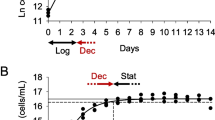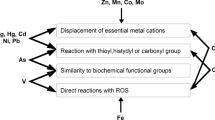Abstract
The products that employ nanoparticles (NPs) in their composition have increased since the beginning of NP production; hence, their availability in the environment, especially in aquatic ecosystems, tends to increase. In these ecosystems, the phytoplankton is immersed in a complex matrix of nutrients, excreted materials, and other chemical compounds, which can influence the metabolic strategy of microalgae. One of the metabolic ways is mixotrophy, a situation whereby microalgae perform photosynthesis and use dissolved organic carbon at the same time. Most toxicity evaluations do not consider such a metabolic route, but this can represent a preferential metabolism in natural environments. The present study aimed at evaluating the effects of NP-TiO2 at a log concentration range of − 3.10 to 0.89, on photosynthesis, growth, viability, and biochemical composition of the microalgae Chlorella sorokiniana during photoautotrophic and mixotrophic growth (glucose as the organic carbon source). The results showed lower chlorophyll a and photosynthetic activity in mixotrophy than in photoautotrophy, which can be due to a decreased need for photosynthesis in mixotrophy. Photoautotrophy cultures were sensitive to NPs, reaching 39% of viability at log 0.89, while in mixotrophy, cell viability was not affected by NPs. The biochemical composition and cell density changed as a function of NP concentrations, with increase in the protein/carbohydrate ratio in both treatments. The results showed that C. sorokiniana is more resistant to NPs during mixotrophic growth, but with changes in biochemical composition, whereas the photoautotrophic cultures were more sensitive to the increase in NP concentrations.






Similar content being viewed by others
References
Albalasmeh, A. A., Berhe, A. A., & Ghezzehei, T. A. (2013). A new method for rapid determination of carbohydrate and total carbon concentration using UV spectrophotometry. Carbohydrate Polymers, 97, 253–261.
Alkhamis, Y., & Qin, J. G. (2016). Comparison of pigment and proximate composition of Tisochrysis lutea in phototrophic and mixotrophic cultures. Journal of Applied Phycology, 25, 35–42.
Araujo, C. F. C., & Souza-Santos, L. P. (2013). Use of the microalgae Thalassiosira weissflogii to assess water toxicity in the Suape industrial-port complex of Pernambuco, Brazil. Ecotoxicology and Environmental Safety, 89, 212–221.
Aruoja, V., Dubourguier, H. C., Kasemets, K., & Kahru, A. (2009). Toxicity of nanoparticles of CuO, ZnO and TiO2 to microalgae Pseudokirchneriella subcapitata. Science of the Total Environment, 407, 1461–1468.
Baldisserotto, C., Giovanardi, M., Ferrori, L., & Pancaldi, S. (2014). Growth, morphology and photosynthetic responses of Neochloris oleoabundans during cultivation in a mixotrophic brackish medium and subsequent starvation. Acta Physiologiae Plantarum, 36, 461–472.
Barreto, D. M., & Lombardi, A. T. (2016). Environmentally relevant concentrations of TiO2 nanoparticles affected cell viability and photosynthetic yield in the Chlorophyceae Scenedesmus bijugus. Water, Air, & Soil Pollution, 227, 450.
Beer, C., Foldbjerg, R., Hayashi, Y., Sutherland, D. S., & Autrup, H. (2012). Toxicity of silver nanoparticles—nanoparticle or silver ion? Toxicology Letters, 208, 286–292.
Bradford, M. (1976). A rapid and sensitive method for the quantization of microgram quantities of protein utilizing the principle of protein-dye binding. Analytical Biochemistry, 72, 243–254.
Cardinale, B. J., Bier, R., & Kwan, C. (2012). Effects of TiO2 nanoparticles on the growth and metabolism of three species of freshwater algae. Journal of Nano Research, 14, 913.
Cherchi, C., Miljkovic, M., Diem, M., & Gu, A. Z. (2015). nTiO2 induced changes in intracellular composition and nutrient stoichiometry in primary producer—Cyanobacteria. Science of the Total Environment, 512-513, 345–352.
Chia, M. A., Lombardi, A. T., Melão, M. G. G., & Parrish, C. C. (2013). Combined nitrogen limitation and cadmium stress stimulate total carbohydrates, lipids, protein and amino acid accumulation in Chlorella vulgaris (Trebouxiophyceae). Aquatic Toxicology, 160, 87–95.
Dalaia, S., Pakrashia, S., Nirmalaa, M. J., Chaudhria, A., Chandrasekarana, N., Mandalb, A. B., & Mukherjeea, A. (2013). Cytotoxicity of TiO2 nanoparticles and their detoxification in a freshwater system. Aquatic Toxicology, 138-139, 1–11.
Franklin, N. M., Rogers, N. J., Apte, S. C., Batley, G. E., Gadd, G. E., & Casey, P. S. (2007). Comparative toxicity of nanoparticles ZnO, bulk ZnO, and ZnCl2 to a freshwater microalga (Pseudokirchneriella subcapitata): the importance of particle solubility. Environmental Science & Technology, 41, 8484–8490.
Ganf, G. G., Stone, S. J. L., & Oliver, R. L. (1986). Use of protein to carbohydrate ratios to analyse for nutrient deficiency in phytoplankton. Australian Journal of Marine and Freshwater Research, 37(2), 183–197.
Giovanardi, M., Baldisserotto, C., Ferrori, L., Longoni, P., Cella, R., & Pancaldi, S. (2014). Growth and lipid synthesis promotion in mixotrophic Neochloris oleoabundans (Chlorophyta) cultivated with glucose. Protoplasma, 251, 115–125.
Gottschalk, F., Sonderer, T., Scholz, R. W., & Nowack, B. (2009). Modeled environmental concentrations of engineered nanomaterials (TiO2, ZnO, Ag, CNT, fullerenes) for different regions. Environmental Science and Technology, 43, 9216–9222.
Granum, E., Kirkvold, S., & Myklestad, S. M. (2002). Cellular and extracellular production of carbohydrates and amino acids by the marine diatom Skeletonema costatum: diel variations and effects of N depletion. Marine Ecology Progress Series, 242, 83–94.
Hartmann, N. B., Der Kammer, F. V., Hofmann, T., Baalousha, M., Ottofuelling, S., & Baun, A. (2010). Algal testing of titanium dioxide nanoparticles: testing considerations, inhibitory effects and modification of cadmium bioavailability. Toxicology, 269, 190–197.
Hund-Rinke, K., & Simon, M. (2006). Ecotoxic effect of photocatalytic active nanoparticles (TiO2) on algae and daphnids. Environmental Science and Pollution Research, 13, 225–232.
Juntila, D. J., Bautista, M. A., & Monotilla, W. (2015). Biomass and lipid production of a local isolate Chlorella sorokiniana under mixotrophic growth conditions. Bioresource Technology, 191, 395–398.
Kadar, E., Rooks, P., Lakey, C., & White, D. A. (2012). The effect of engineered iron nanoparticles on growth and metabolic status of marine microalgae cultures. Environmental Science and Technology, 439, 8–17.
Kaegi, R., Ulrich, A., Sinnet, B., Banbank, R., Wichser, A., Zuleeg, S., Simmler, H., Brunner, S., Vonmont, H., Burkhardt, M., & Boller, M. (2008). Synthetic TiO2 nanoparticle emission from exterior facades into the aquatic environment. Environmental Pollution, 156, 233–239.
Kahru, A., & Dubourguier, H. C. (2010). From ecotoxicology to nanoecotoxicology. Toxicology, 269, 105–119.
Kaplan, D., Heimer, Y. M., Abeliovich, A., & Goldsbrough, P. B. (1995). Cadmium toxicity and resistance in Chlorella sp. Plant Science, 109, 129–137.
Kilham, S. S., Kreeger, D. A., Goulden, C. E., & Lynn, S. G. (1997). Effects of nutrient limitation on biochemical constituents of Ankistrodesmus falcatus. Freshwater Biology, 38, 591–596.
Komor, E., & Tanner, W. (1974). The hexose-proton symport system of Chlorella vulgaris: specificity, stoichiometry and energetics of sugar-induced proton uptake. European Journal of Biochemistry, 44, 219–223.
Kong, W., Song, H., Cao, Y., Yang, H., Hua, S., & Xia, C. (2011). The characteristics of biomass production, lipid accumulation and chlorophyll biosynthesis of Chlorella vulgaris under mixotrophic cultivation. African Journal of Biotechnology, 10, 11620–11630.
Kulacki, K. J., & Cardinale, B. J. (2012). Effects of nano-titanium dioxide on freshwater algal population dynamics. PLoS One, 7(10), e47130.
Kumar, K. S., Dahms, H. U., Lee, J. S., Kim, H. C., Lee, W. C., & Shin, K. H. (2014). Algal photosynthetic responses to toxic metals and herbicides assessed by chlorophyll a fluorescence. Ecotoxicology and Environmental Safety, 104, 51–71.
Li, T., Zheng, Y., Yu, L., & Chen, S. (2014). Mixotrophic cultivation of a Chlorella sorokiniana strain for enhanced biomass and lipid production. Biomass & Bioenergy, 66, 204–213.
Liang, Y., Sarkany, N., & Cui, Y. (2009). Biomass and lipid productivities of Chlorella vulgaris under autotrophic, heterotrophic and mixotrophic growth conditions. Biotechnology Letters, 31, 1043–1049.
Linkous, C. A., Carter, G. L., Locuson, D. B., Ouellette, A. J., Slattery, D. K., & Smitha, L. A. (2000). Photocatalytic inhibition of algae growth using TiO2, WO3, and cocatalyst modifications. Environmental Science and Technology, 34, 4754–4758.
Lombardi, A. T., & Maldonado, M. T. (2011). The effects of copper on the photosynthetic response of Phaeocystis cordata. Photosynthesis Research, 108, 77–78.
Melegari, S. P., Perreault, F., Costa, R. H. R., Popovic, R., & Matias, W. G. (2013). Evaluation of toxicity and oxidative stress induced by cooper oxide nanoparticles in the green alga Chlamydomonas reinharstii. Aquatic Toxicology, 142-143, 431–440.
Miao, A. J., Schwehr, K. A., Xu, C., Zhang, S. J., Luo, Z., Quigg, A., & Santschi, P. H. (2009). The algal toxicity of silver engineered nanoparticles and detoxification by exopolymeric substances. Environmental Pollution, 157, 3034–3041.
Mueller, N. C., & Nowack, B. (2008). Exposure modeling of engineered nanoparticles in the environment. Environmental Pollution, 157, 3034–3041.
Navarro, E., Baun, A., Behra, R., Hartmann, N. B., Filser, J., Miao, A. J., Quigg, A., Santschi, P. H., & Sigg, L. (2008). Environmental behavior and ecotoxicity of engineered nanoparticles to algae, plants, and fungi. Ecotoxicology, 17, 372–386.
Nel, A., Xia, T., Madler, L., & Li, N. (2006). Toxic potential of materials at the nanolevel. Science, 311, 622–627.
Nowack, B., & Bucheli, T. D. (2007). Occurrence, behavior and effects of nanoparticles in the environment. Environmental Pollution, 150, 5–22.
Perales-Vela, H. V., Peña-Castro, J. M., & Cañizares-Villanueva, R. O. (2006). Heavy metal detoxification in eukaryotic microalgae. Chemosphere, 64, 1–10.
Perez-Garcia, O., Escalante, F. M. E., de-Bashan, L. E., & Bashan, Y. (2011). Heterotrophic cultures of microalgae: metabolism and potential products. Water Research, 45, 11–36.
Piccinno, F., Gottschalk, F., Seeger, S., & Nowack, B. (2012). Industrial production quantities and uses of ten engineered nanomaterials for Europe and the world. Journal of Nano Research, 14, 1109–1120.
Rausch, T. (1981). The estimation of micro-algal protein content and its meaning to the evaluation of algal biomass I. Comparison of methods for extracting protein. Hydrobiologia, 78, 237–251.
Reynolds, C. S. (2006). The ecology of phytoplankton (p. 551). Cambridge: Cambridge University Press.
Ridley, M. K., Hackley, V. A., & Machesky, M. L. (2006). Characterization and surface-reactivity of nanocrystalline anatase in aqueous solutions. Langmuir, 22, 10972–10982.
Robichaud, C. O., Uyar, A. E., Darby, M. R., Zucker, L. G., & Wiesner, M. R. (2009). Estimates of upper bounds and trends in nano-TiO2 production as a basis for exposure assessment. Environmental Science and Technology, 43(12), 4227–4233.
Rocha, G. S., Pinto, F. H. V., Melão, M. G. G., & Lombardi, A. T. (2015). Growing Scenedesmus quadricauda in used culture media: is it viable? Journal of Applied Phycology, 27, 171–178.
Rosemberg, J. N., Kobayashi, N., Barnes, A., Noel, E. A., Betenbaugh, M. J., & Oyler, G. A. (2014). Comparative analyses of three Chlorella species in response to light and sugar reveal distinctive lipid accumulation patterns in the microalga C. sorokiniana. PLoS One, 9(4), e92460.
Sadiq, I. M., Pakrashi, S., Chandrasekaran, A. M., & Mukherjee, A. (2011). Studies on toxicity of aluminum oxide (Al2O3) nanoparticles to microalgae species: Scendesmus sp. and Chlorella sp. Journal of Nanoparticle Research, 13, 3287–3299.
Sharma, V. K. (2009). Aggregation and toxicity of titanium dioxide nanoparticles in aquatic environment—a review. Journal of Environmental Science and Health, 44, 1485–1495.
Tang, Y. Z., & Dobbs, F. C. (2007). Green autofluorescence in dinoflagellates, diatoms, and other microalgae and its implications for vital staining and morphological studies. Applied and Environmental Microbiology, 73(7), 2306–2313.
USEPA (2012). Ecological effects test guidelines—OCSPP 850.4500: Algal Toxicity (pp. 28). Washington, DC.
Yang, W. W., Miao, A. J., & Yang, L. Y. (2012b). Cd2+ toxicity to a green alga Chlamydomonas reinhardtii as influenced by its adsorption on TiO2 engineered nanoparticles. PLoS One, 7(3), e32300.
Yang, Z., Geng, L., Wang, W., & Zhang, J. (2012a). Combined effects of temperature, light intensity, and nitrogen concentration on the growth and polysaccharide content of Microcystis aeruginosa in batch culture. Biochemical Systematics and Ecology, 41, 130–135.
Zhan, W. X. (2003). Nanoscale iron particles for environmental remediation: an overview. Journal of Nanoparticle Research, 5, 323–332.
Zhu, X., Zhou, J., & Cai, Z. (2011). TiO2 nanoparticles in the marine environment: Impact on the toxicity of tributyltin to abalone (Haliotis diversicolor supertexta) embryos. Environmental Science and Technology, 45, 3753–3758.
Acknowledgments
The authors thank the Brazilian agency FAPESP (Proc. No. 2014/15894-0) and CNPq (Proc. No. 302175/2015-6) for financial support.
Author information
Authors and Affiliations
Corresponding author
Rights and permissions
About this article
Cite this article
Marchello, A.E., Barreto, D.M. & Lombardi, A.T. Effects of Titanium Dioxide Nanoparticles in Different Metabolic Pathways in the Freshwater Microalga Chlorella sorokiniana (Trebouxiophyceae). Water Air Soil Pollut 229, 48 (2018). https://doi.org/10.1007/s11270-018-3705-5
Received:
Accepted:
Published:
DOI: https://doi.org/10.1007/s11270-018-3705-5




